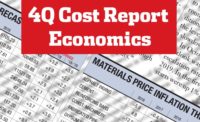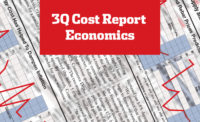As 2023 comes to a close, experts are fairly optimistic about the economic outlook for construction in 2024, but not without some words of caution.
“The construction sector will see brighter days in 2024. Recent macroeconomic data from employment numbers to the consumer and producer prices indices show that the economy is easing back and pulling inflation lower with it,” says Richard Branch, chief economist at Dodge Construction Network. “It’s increasingly likely that the Fed will pivot and start lowering the Fed Funds rate leading to a more positive climate for building.”
However, he adds: “The sector, though, is not out of the woods. Interest rates will remain high for the immediate future and credit remains tight. This means that construction starts will likely tread water over the next several months.”
Julian Anderson, president of Rider Levett Bucknall, expressed a similar sentiment. “While the risk of a general economic recession has receded, the near term future for construction is hazy,” he says. “Of course, the fall back is uneven with private sector projects feeling the effect more than public sector ones.”
Little Movement for Residential Starts
In the residential sector, single-family housing made modest progress over the course of 2023 before falling again in the three final months of the year. Dodge predicts that starts won’t pick up again until the second half of 2024. On the multifamily side, “starts have been trending lower in 2023 as new supply has come online, pushing vacancy rates higher,” says Branch. Overall, the number of units to start construction in 2023 is 15% lower year-to-date through November.
Among the largest multifamily projects to break ground in the third quarter was the $364-million QPX mixed-use building in Long Island City in Queens, N.Y., as well as a $350-million mixed-use project on 37th street in New York City.
On the non-residential side, starts are down 7% through the first 11 months of the year, according to Dodge. “The weakness has been mostly felt within the commercial space as office and warehouse work have pulled back as Amazon builds fewer warehouses and hybrid work options expand,” Branch says. He also notes that the labor shortage contributed to the decline, as projects were pushed to 2024 to allow time to find available workers.
The largest nonresidential projects to get started in October and November were the $7.5-billion Micron semiconductor fab plant in Boise and the $2.2-billion Hyundai/LG EV battery plant in Ellabell, Ga.
Non-building starts were the “clear winner” in 2023, Branch says, up 19% year-to-date in the first 11 months. “IIJA funding is flowing into the market, leading to solid gains in highway, bridge and sewer work.” Starts in the electric power sector have also “flourished”, along with solar, wind and LNG projects.
The largest non-building projects to begin recently were the $834-million I-405 Brickyard to SR527 improvements in Bothell, Wa., and the $406-million second phase of the Sherco Solar project in Becker, Minn.
Steady Prices Expected for Lumber
Looking at building costs, the fourth quarter forecast from S&P Global predicts a modest 1.1% increase in softwood lumber in 2024, following a 30.7% decline in 2023. Plywood prices are expected to drop 1.1% in 2024, after ending 2023 down 16.8%.
“Softwood lumber prices will see a modest seasonal increase to start 2024 as construction demand starts for the spring, before remaining fairly steady through the end of the year,” says Luke Lillehaugen, senior economist at S&P Global. “Demand headwinds will continue for the foreseeable future as mortgage rates remain high and weigh on residential construction demand.”
.jpg?1671747499)


.jpg?height=200&t=1671747499&width=200)


Post a comment to this article
Report Abusive Comment